Description
The slogan on Ontario’s licence plates, ‘Yours to Discover,’ was designed to promote travel opportunities within the province. Every year, thousands of tourists drive along country roads, past farmyards and through hamlets, en route to popular vacation spots. In Looking for Old Ontario, Thomas McIlwraith shows that many destinations are closer at hand than one might imagine, and invites travellers to rediscover familiar countryside landmarks by ‘reading’ them as chapters in a rich historical narrative. Surveyors long ago scored Ontario’s land, and generations have since inscribed it with residences, businesses, and institutions. This book, the result of thirty years of field work and archival research, is a reflection on and an interpretation of the ways in which the land and its inhabitants interrelate.
Looking for Old Ontario guides readers through the vernacular landscape of the province, examining barns, fences, jails, post offices, inns, mills, canals, railways, roadsides, cemeteries, and much more. McIlwraith emphasizes ordinary features of the cultural landscape which communicate social meaning to the observant eye. The landscape tells us that Ontario has been inhabited by thrifty people; this we can conclude by looking at the economical use and reuse of construction materials. Yet the landscape also tells us that Ontario’s residents have been inclined to show off: consider the province’s unusually large number of elegant brick dwellings. To read a landscape is to think about such connections, and McIlwraith’s contemplative style differentiates his work from manuals or handbooks.
Since landscape interpretation is a highly visual subject, Looking for Old Ontario is extensively illustrated with photographs, drawings, and maps. It will be useful to general readers interested in recognizing the broader meanings of their communities’ heritage, as well as to students of geography, history, and planning.




